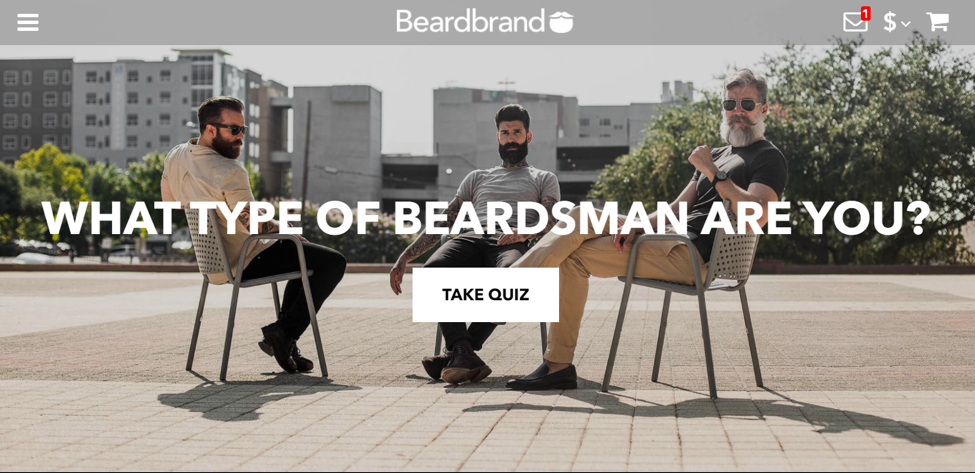Entrepreneurs shouldn’t be ashamed to admit it: going global can be scary. Even for established brands, international ecommerce multiplies everything .…
- Multiple storefronts
- Multiple currencies
- Multiple shipping and fulfillment locations
- Multiple tax regulations … all from
- Multiple governments
The sheer number of moving parts required for success is overwhelming. Thankfully, there’s a lot to learn from the top international ecommerce websites that successfully expanded:
- BeardBrand: Focus on a Specific, Targeted Audience
- QuadLock: Localize Your Brand as It Expands
- Rebecca Minkoff: Make Currency Selection Easy
- SkinnyMe Tea: Stay Relevant with Social Marketing
- Gymshark: Pop-Up Everywhere Your Customers Live
- 100% Pure: Unify Your Backend Processes
- ASOS: Smart Shipping and Logistics Strategy
- REVOLVE: Track, Analyze, and Optimize
- Nike: Create an Omni-Channel Experience
- Nordstrom: Keep Customers as Your Nucleus
1. BeardBrand: Focus on a Specific, Targeted Audience
It’s not a revolutionary concept that standing out from your competitors is a solid way to outperform them. But many brands struggle to find a unique selling point that sets them apart.
BeardBrand found incredible success by carving its niche, generating $120k per month in revenue within just a year of opening its eDoors. The company coined a term for a hyper-specific target audience called the “urban beardsman.” The brilliance behind this is that the company essentially created an identity for their customers, which in turn made them part of the brand’s story and sparked a cultural phenomenon.
Founder Eric Bandholz writes:
“With Beardbrand we developed the term ‘urban beardsman,’ which describes a man with a beard who cares about their style, their grooming habits, and who has a plan and a vision with their personal life.”
“Traditionally beardsmen were thought of as hippies, bikers, outdoorsmen, or homeless folks. We wanted to unite people who didn’t feel like they fit those labels.”
Think about your products and offerings and the types of customers you already have. Do they share any unique traits that can be further segmented and spoken to?
This may be your key to rapid expansion and taking over new markets.
2. QuadLock: Localize Your Brand as It Expands
You can’t just flop into unknown territory with a one-size-fits-all strategy. What works in one region can be a nosedive in another. This is compounded by things like cultural differences in interests and behavior, product demand and accessibility, and local currencies and economies.
Language alone is a huge barrier: a survey of non-Anglophone countries in Asia, Europe, and South America revealed that 75% prefer shopping in their native language and 60% rarely or never purchase from an English-only website.
Apart from language, other localization strategies include currency matching (which we’ll discuss next), tailoring product selection to regional shopping behaviors, and examining the impact of certain branding elements. For example, while the color purple can symbolize wealth and power in the Middle East and U.S., it’s associated with mourning and death in Latin America and Thailand.
Quad Lock saw an incredible increase in global orders when it took the initiative to localize. When it originally expanded, the site offered global shipping from its U.S.-based site. The company now has six localized versions including Europe, Japan, the U.K., and Australia, as well as an international website that serves regions outside of the six.
These versions each have their own inventory, domain, currency, payment gateway, and backend shop.
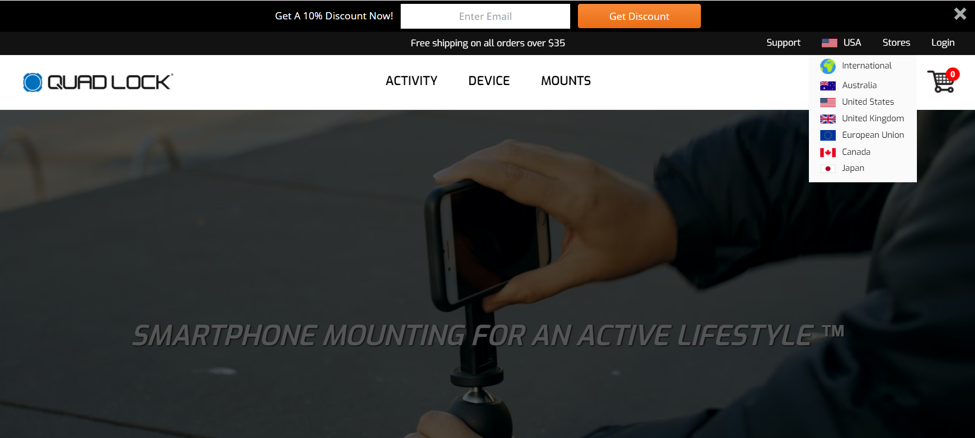
Baby Tula is another global ecommerce company that found incredible success through its localization strategy. Their special touch is geography-specific price lists and policies, in addition to separate sites for their North American, U.K., and European customers.

When trying to decide which regions to localize first, dig into your analytics and performance for key trends. On a more obvious layer, which regions have the highest traffic and sales? Look at more nuanced data too, like which regions have the most abandoned shopping carts and get the most inquiries from potential customers asking if you ship there.
The more comprehensively you can localize your brand, the more relatable and trustworthy you’ll become to shoppers.
3. Rebecca Minkoff: Make Currency Selection Automatic and Easy
While creating different versions of your site might be outside your bandwidth at the moment, you can always take smaller steps to streamline and expedite the shopping process for customers in different regions. One of the biggest efforts you can take in accommodating localized audiences is to adapt to their currency.
Rebecca Minkoff has achieved pro status with its robust geography and currency selector that supports hundreds of countries and more than 70 currencies. Seriously. You can shop in Kuwaiti dinar, Thai baht, Swedish krona, Turkish lira, Ukrainian hryvnia … you get the point.
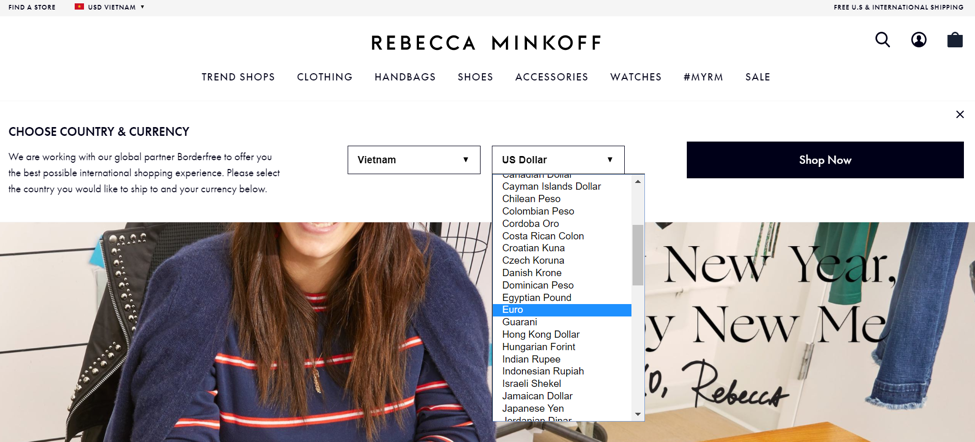
And it’s easy to access, with the menu button always hanging out in the top left corner of the company’s Shopify Plus store.
4. SkinnyMe Tea: Stay Relevant with Social Marketing
As consumers are getting flooded with ad and marketing messaging, every passing day creates a bigger urgency to meet customers where they are. If you’ve got the right brand for it, social marketing can bring incredible returns for minimal investment.
Research in the Journal of Internet Commerce shows that engagement with a brand’s social media communities leads to higher customer engagement, which in turn leads to higher trust and word-of-mouth activities.
SkinnyMe Tea had a unique product – founder Gretta Rose van Riel basically created and dominated the “teatox” market – that was bolstered by savvy influencer marketing. The company even won the Shopify Build-A-Business Competition.
Van Riel says her secret was honing in on social media micro-influencers who have common values and identities with her brand and her target market.
As opposed to macro-influencers, micro-influencers have smaller audience numbers, but they build a higher level of trust because they typically have higher engagement with their audiences and their social profiles aren’t stuffed with ads.
Van Reil’s strategy is simple:
“Every time I see somebody that fits our audience and demographic—health-conscious female with over 1,000 followers and out of high school too, which was one of my criteria for her to be over 18—every time I’d see them, I’d screenshot them and I’d reach out to them on Instagram …
“I would just literally put a comment, grab their email, and send them some tea.”

SkinnyMe Tea is a testament to how, in the world of social marketing, a little bit can go a very long way.
5. Gymshark: Pop-Up Everywhere Your Customers Live
Just because you don’t have brick-and-mortar stores doesn’t mean you can’t make an appearance. And research consistently shows that physically interacting with products can make consumers more likely to purchase them.
Harvard Business Review notes:
Physically holding products can create a sense of psychological ownership, driving must-have purchase decisions.
Gymshark has mastered the art of bringing their online world into customers’ hands with their international pop-up stores. These events typically last two or three days, and they feature guest appearances from the famous faces and designers you find in their online selection, like Whitney Simmons, David Laid, and Nikki Blackketter.
At some of these pop-ups, Gymshark also offers special products that can only be purchased at the event, like the limited edition Flex Legging colors they offered at their 5th birthday celebration pop-up in London.
To minimize FOMO among their loyal customers who couldn’t be there, the company offered a virtual tour of another pop-up on their site.

Gymshark is a stellar example of a top international company that uses a global website to facilitate an omni-channel strategy, blurring the lines between unique in-store and online experiences for its customers.
6. 100% Pure: Unify Your Backend Processes
The more diverse your business offerings, the more cogs you’ll have to keep well-oiled. For some businesses, this can result in too many apps, programs, platforms, and partners to keep track of harmoniously and in real time.
100% Pure realized that it was losing hundreds of thousands of dollars a month because of its slow and inflexible ecommerce platform. The team made the switch to Shopify Plus, solving their speed issue, giving them a sleek customer-facing portal in five countries, and allowing them to unify their backend tools and systems.
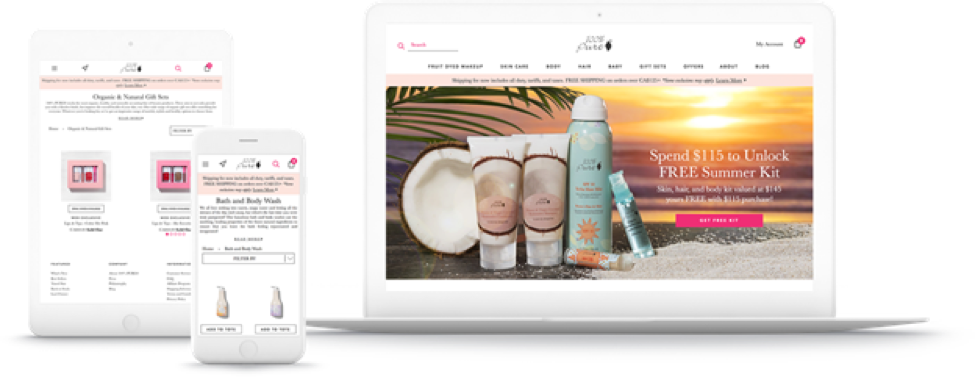
They used the Shopify API to create what they call the Purity Toolbox, which collects custom connections to manage their product information, inventory syncing, and digital marketing resources. With the click of a button, they’re positioned to update each of their physical and digital properties.
Quan Nguyen, VP of Technology, says:
I just hit the sync button and it’s done. We save so much time being able to sync everything across multiple stores.
Not only were they better positioned to manage their inventory across warehouses in the U.S., Europe, and Canada, they were also able to expand into China and easily launch new brands. Their operations are optimized and ready for whatever the next step might be.
7. ASOS: Smart Shipping and Logistics Strategy
Even domestically, you’re quite familiar with how much of an impact your shipping and logistics strategy can have on pretty much every aspect of your business.
U.K. ecommerce powerhouse ASOS set a place for itself at the global table by focusing on delivery and warehouse solutions as part of the core aspects of their business, with one of their main draws being free worldwide shipping and returns.
The company set up a series of systems, including shipments with several international carriers, fully tracked drop-off at over 13,000 outlets and post offices, and warehouses to help serve local buyers.
The company even offers same-day deliveries for many customers and regions.
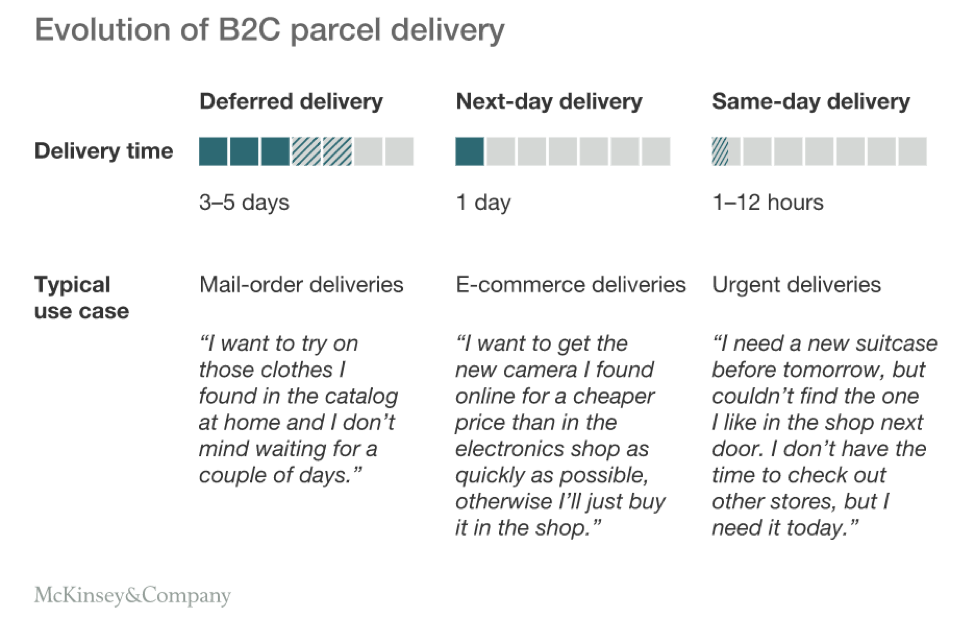
CEO Nick Robertson says:
A good delivery experience is a key part of keeping our customers happy and encouraging repeat purchases as well as helping to build brand warmth.
You might be thinking, “That’s great for them, but free shipping and returns would murder my business. Get outta here.” And that’s true for many companies.
But offering free shipping may not be as distant of a dream as you might think. Consider techniques like opting for flat rate shipping containers, optimizing around your average box size, and strategically calculating your free shipping thresholds.
You can also try parcel forwarding, which is essentially bulk international shipping to a local shipping hub. These local hubs then take responsibility for shipping to the customer, which can work to cut your costs and pass them down to your customers.
8. REVOLVE: Don’t Stop Tracking, Analyzing, and Optimizing
A fatal flaw of expansion – and business in general – is the content feeling of success that leads entrepreneurs to believe that the work is over and it’s time to relax. While you may be over the hump after the initial expansion, there’s always room to learn and evolve. What’s more is that the ecommerce landscape is changing so fast that what works now might be obsolete in just a few months.
This is where analytics and optimization are your best friend.
Designer clothing and accessories retailer REVOLVE can attest to the glory of optimization and number-crunching. Since its birth in 2003, the company has constantly used data and search terms to help predict fashion trends that fueled their product lines.
Grace Hong, VP of Product and Design, understands the urgency of ecommerce:
“If our customer doesn’t see the perfect dress for her on the first page she visits, she’s likely to move on to the next app or site vying for her attention. It’s absolutely necessary to show her what she wants as soon as she comes to us — even if she doesn’t yet know what that item is.”
The company uses A/B testing with Optimizely to make sure customers are getting exactly what they want, from onsite pop-ups for newsletter registrations to the positioning of their “Hot List” in the site’s nav bar, to testing out landing pages for mobile app downloads.
For example, they found that by offering a splash page discount for mobile purchases, mobile app downloads increased by an incredible 350%.

REVOLVE understands the ephemeral nature of online shopping behaviors and trends and works to make sure that they’re on top of every new development.
9. Nike: Create an Omni-Channel Experience
If you caught me a couple of years ago, I would’ve told you that omni-channel retailing is the future. But here we are, and omni-channel is now. With technology infiltrating pretty much every crevice of our lives, the brand-customer relationship is evolving rapidly to accommodate. Another part of the customer experience formula is an omni-channel strategy.
Research shows that 75% of consumers expect a consistent engagement experience every time they interact with a brand, whether it’s in-store, calling the customer service line, shopping online, or web engagement like social media.
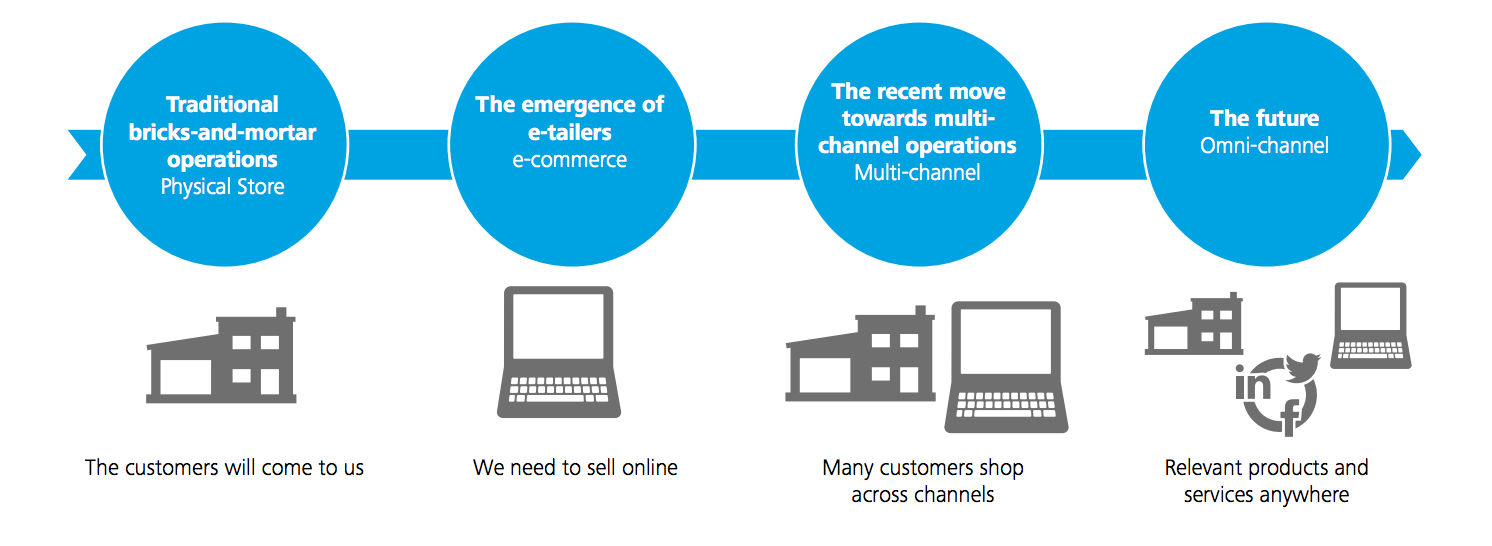
Nike is a classic example of a global ecommerce company doing omni-channel right. At the heart of its omni-channel experience is the Nike+ (pronounced NikePlus) program. In a 2006 partnership with Apple, the first iteration of the program allowed customers to connect their Nike shoes to their iPod, allowing them to track their workout performance stats like time, distance, and calories burned.
In 2016, Nike+ expanded into a personalized app, developing into a community for its users. Nike built and nurtured its retention strategy and loyalty program to create lasting customers, describing the program as:
Everything you want from Nike, all in one place. Products and events reserved for you, expert advice from the world’s greatest athletes, and your own personal Nike shop.
User information and activity is synced with the Nike+ website, where users can also connect to the rest of the Nike app suite like Nike+ Run Club, Training Club, and SNKRS apps. The onboarding process for these apps involves questions about the customer’s favorite Nike products, brands, and sports, which the app uses to suggest products through a personalized newsfeed.
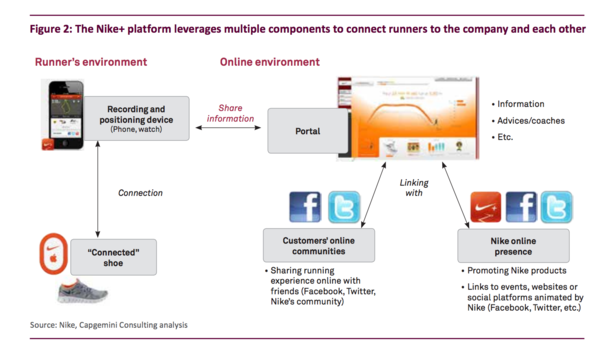
In addition to this imaginative digital world, the powerhouse brand also owns its direct-to-consumer and retailing strategies, along with its evergreen ability to stay relevant by tapping into social media trends and movements.
Nike understands the value in a holistic, multi-touch customer experience and it delivers without fail.
10. Nordstrom: Keep Customers as the Nucleus of Your Brand
With unprecedented control over their shopping experience, customers are getting savvier… and more demanding. In a study of 10,000 U.S. consumers, 86% said they would likely repurchase from a company that gave them a great experience. In another study, 50% of consumers said they’re likely to switch brands if a company fails to anticipate their needs.
Walker predicts that by 2020, customer experience will surpass product and price as a brand’s key differentiator.
Nordstrom is a great example of a global ecommerce company that knows the value of staying religiously customer-centric, and it’s paid off – the brand name is practically synonymous with exemplary customer service.
The company has several brands, including physical stores, Nordstrom Online, Nordstrom Rack, and Trunk Club. They create a seamless experience for their customers by connecting these data systems so that it’s easy for customers to make purchases and access their cross-brand accounts.
In terms of communication, if you contact the company with a complaint or issue, you’re likely to receive a response in minutes as opposed to hours or days. And it won’t be a bot or automated message, either (which in today’s ecommerce world is can actually be shocking for some).
They’re so good that they even wrote two handbooks on customer service, the second of which is titled The Nordstrom Way to Customer Service Excellence: The Handbook for Becoming the “Nordstrom” of Your Industry.
…You could say they’re confident about their reputation.
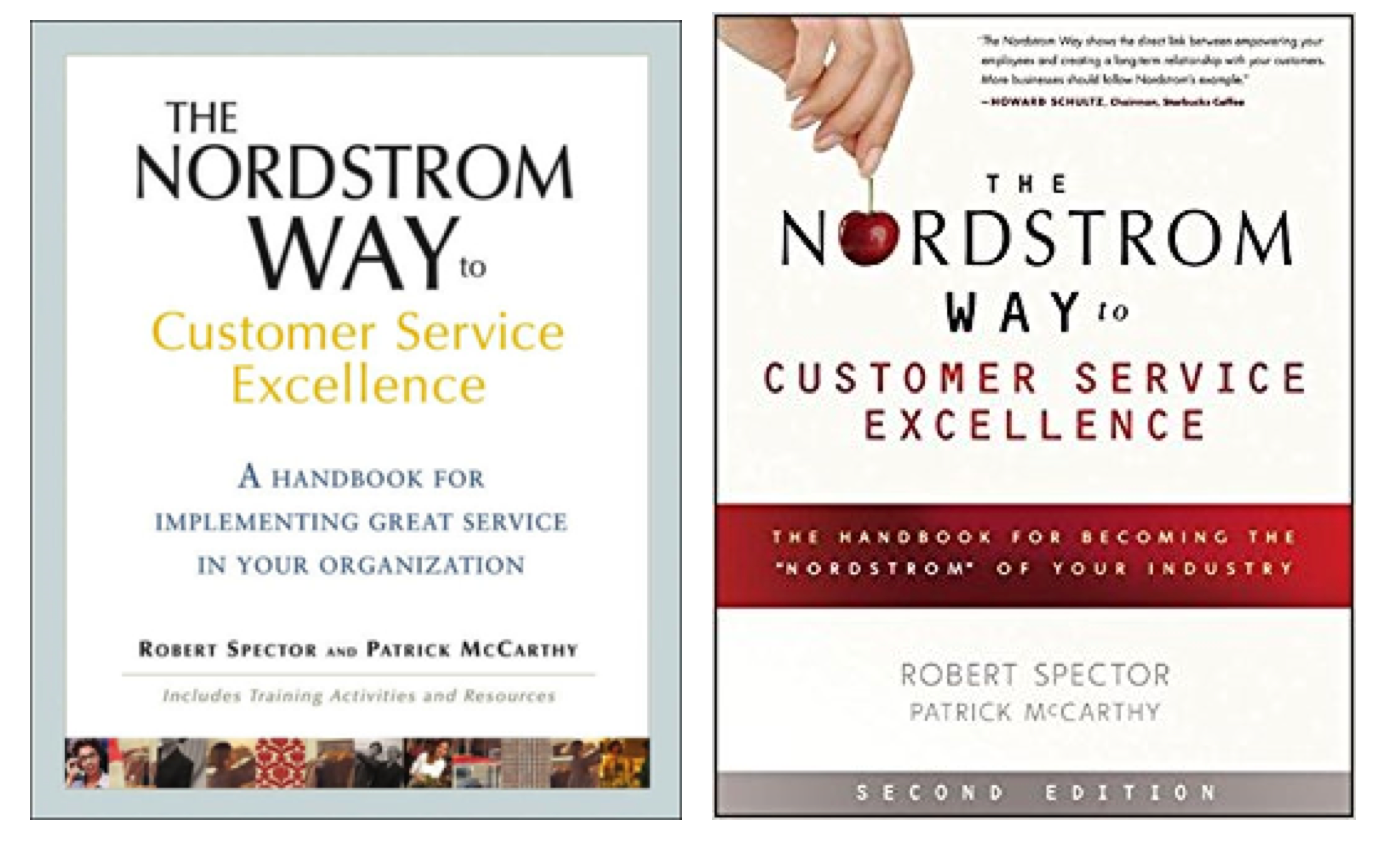
Take Notes and Fly the Nest
These international ecommerce companies are just a few examples of how to master the art and science of international expansion. It’s critical to do your research about the regions you’re expanding to so that you can seamlessly accommodate the customers’ needs and wants – basic factors like local language and currency are non-negotiable.
Once you know the traits of successful brands in these areas, you can weave them into your operations and strategy to make sure that the customer always has an exceptional experience whenever your brand is on the table.
When you have a data-backed plan and the right tools to implement it, the thought of becoming a global ecommerce company morphs from scary to achievable.



